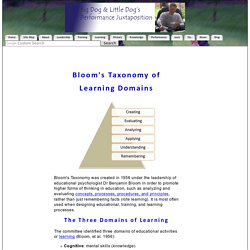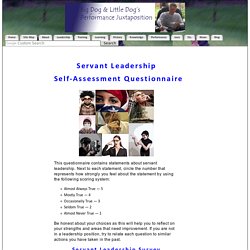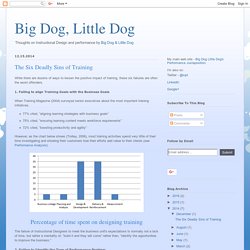

Big Dog and Little Dog's Performance Juxtaposition. A to Z of Learning. ADDIE Backwards Planning Model. Agile Learning Design: An Ethos for Creating Learning, Training, and Performance Processes. Software design and related practices and methods have had a significant influence over the Instructional Design field.

Bloom's Taxonomy of Learning Domains: The Cognitive Domain. Bloom's Taxonomy was created in 1956 under the leadership of educational psychologist Dr Benjamin Bloom in order to promote higher forms of thinking in education, such as analyzing and evaluating concepts, processes, procedures, and principles, rather than just remembering facts (rote learning).

It is most often used when designing educational, training, and learning processes. The Three Domains of Learning The committee identified three domains of educational activities or learning (Bloom, et al. 1956): Cognitive: mental skills (knowledge) Affective: growth in feelings or emotional areas (attitude or self) Psychomotor: manual or physical skills (skills) Since the work was produced by higher education, the words tend to be a little bigger than we normally use. While the committee produced an elaborate compilation for the cognitive and affective domains, they omitted the psychomotor domain.
Cognitive Domain Knowledge Comprehension Application Analysis Synthesis Evaluation. Design. Design brings forth what does not come naturally.

While science is concerned with how things are, design is concerned with how things ought to be. “Everyone designs who devises courses of action aimed at changing existing situations into preferred ones. The intellectual activity that produces material artifacts is no different fundamentally from the one that prescribes remedies for a sick patient or the one that devises a new sales plan for a company or a social welfare policy for a state.” - Herbert Simon (Nobel Prize Winner & Carnegie Mellon professor) The table below shows five popular design methodologies (Instructional System Design, Design Thinking, Agile Design, System Thinking, and X Problem). It includes definitions, visual models, primary focus and goals, values, main steps, and further readings. If you would like to discuss any of these design models, please leave a comment on my blog post.
Servant Leadership Survey. This questionnaire contains statements about servant leadership.

Next to each statement, circle the number that represents how strongly you feel about the statement by using the following scoring system: Almost Always True — 5 Mostly True — 4 Occasionally True — 3 Seldom True — 2 Almost Never True — 1 Be honest about your choices as this will help you to reflect on your strengths and areas that need improvement. If you are not in a leadership position, try to relate each question to similar actions you have taken in the past. Social Leadership Self-Assessment Questionnaire. This is a self-development instrument for assessing Social Leadership attributes.

It is NOT a test, but rather a survey or learning activity that will help you gain critical insight into your leadership strengths and weaknesses. This questionnaire contains statements about Social Leadership. Next to each statement, circle the number that represents how strongly you feel about the statement by using the following scoring system: Almost Always True — 5 Mostly True — 4 Occasionally True — 3 Seldom True — 2 Almost Never True — 1 Be honest about your choices, as this will help you to reflect on your strengths and areas that need improvement.
The Social Leadership Survey Scoring 1. 2. 3. 4. The Art and Science of Leadership. Welcome to the Art and Science of Leadership, a comprehensive collection of articles and activities for developing leadership skills and knowledge.

The Seven Principles of Thinking Like a Leader. This leadership guide uses seven principles of thinking like a leader as a foundation for building leadership skills. 1.

Keep a focus on the mission and higher intent Never lose sight of the mission, purpose, and results you need to achieve. Due to the complexity of their duties, leaders are often drawn toward unusual and critical events that force them in different directions. While these difficulties often need to be attended to, don't lose sight of the higher intent of the organization. Recommended readings: 2. The Six Deadly Sins of Training. While there are dozens of ways to lessen the positive impact of training, these six failures are often the worst offenders. 1.

Failing to align Training Goals with the Business Goals When Training Magazine (2004) surveyed senior executives about the most important training initiatives, 77% cited, “aligning learning strategies with business goals” 75% cited, “ensuring learning content meets workforce requirements” 72% cited, “boosting productivity and agility” However, as the chart below shows (Trolley, 2006), most training activities spend very little of their time investigating and showing their customers how their efforts add value to their clients (see Performance Analysis): Percentage of time spent on designing training The failure of Instructional Designers to meet the business unit's expectations is normally not a lack of time, but rather a mentality of, “build it and they will come” rather than, “identify the opportunities to improve the business.” 2. 3. 4. 5. 6.
The 70:20:10 Learning Model: A Path to the Past. This post arose from Tom Spiglanin's post and comments on Revisiting 70:20:10. 70:20:10 has been good in that it has inspired instructional designers to create broader learning experiences, rather than just courses.

The major problem is that it is based on how a very small group of one profession believed that is how they learned in the past. Instructional System Design: The ADDIE Model - A Handbook for Practitioners. Instructional Design — mLearning. Authentic Leadership Self-Assessment Questionnaire. Unauthentic leaders hide behind masks This questionnaire contains statements about authentic leadership.

Next to each statement, circle the number that represents how strongly you feel about the statement by using the following scoring system: